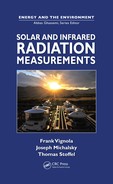Contents
Chapter 1 Measuring Solar and Infrared Radiation
Chapter 2 Solar Resource Definitions and Terminology
2.3 Extraterrestrial Radiation
2.5 Zenith, Azimuth, and Hour Angles
2.6 Solar, Universal, and Local Standard Time
2.7 Solar Position Calculation
2.9 Global, Direct Normal, and Diffuse Irradiance
2.10 Solar Radiation on Tilted Surfaces
2.11 Spectral Nature of Solar Radiation
2.12 Fundamentals of Thermodynamics and Heat Transfer
2.12.3 Radiative Heat Transfer
2.13 Photodiodes and Solar Cell Prerequisites
Chapter 3 Historic Milestones in Solar and Infrared Radiation Measurement
3.2 Earliest Observations of the Sun and the Nature of Light
3.3 Nineteenth–Century Radiometers
3.3.1 Pouillet’s Pyrheliometer (1837)
3.3.2 Campbell-Stokes Sunshine Recorder (1853, 1879)
3.3.3 Ångströ Electrical Compensation Pyrheliometer (1893)
3.3.4 Callendar Pyranometer (1898)
3.3.5 Ångström Tulipan Pyrgeometer (1899)
3.4 Operational Radiometers of the Twentieth Century
3.4.1 Abbot Silver-Disk Pyrheliometer (1906)
3.4.2 Smithsonian Water-Flow Pyrheliometer (1910)
3.4.3 Marvin Pyrheliometer (1910)
3.4.4 Ångström Pyranometer (1919)
3.4.5 Kipp & Zonen Solarimeter (1924)
3.4.6 Robitzsch Bimetallic Actinograph (1932)
3.4.7 Eppley 180º Pyrheliometer (1930)
3.4.9 Yanishevsky Pyranometer (1957)
3.4.10 Eppley Model NIP (1957)
3.4.11 Eppley Model PIR (1968)
3.4.12 Primary Absolute Cavity Radiometer (PACRAD) (1969)
3.4.13 Eppley Model 8–48 (1969)
3.4.14 LI-COR Model LI–200SA (1971)
3.4.15 Rotating Shadowband Radiometer (1975)
3.4.16 World Standard Group (1979)
3.5 Recent Advances in Solar Measurements
3.5.1 Automatic Hickey–Frieden Cavity Radiometer
3.5.2 Total Irradiance Monitor (TIM)
Chapter 4 Direct Normal Irradiance
4.1 Overview of Direct Normal Irradiance
4.3 Operational Thermopile Pyrheliometers
4.4 Absolute Cavity Radiometers
4.5 Uncertainty Analysis for Pyrheliometer Calibration
4.6 Uncertainty Analysis for Operational Thermopile Pyrheliometers
4.6.1 Window Transmittance, Receiver Absorptivity, and Temperature Sensitivity
4.6.2 Solar Zenith Angle Dependence
4.7 Uncertainty Analysis for Rotating Shadowband Radiometer Measurements of Direct Normal Irradiance
4.8 Direct Normal Irradiance Models
4.8.2 Satellite Model Estimates
4.9 Historical and Current Surface-Measured Direct Normal Irradiance Data
Chapter 5 Measuring Global Irradiance
5.1 Introduction to Global Horizontal Irradiance Measurements
5.2 Black–Disk Thermopile Pyranometers
5.2.4 Angle of Incidence Response
5.2.7 Ice and Snow on Dome—Ventilators
5.3 Black-and-White Pyranometers
5.3.1 Characteristics of Black-and-White Pyranometers
5.4 Photodiode-Based Pyranometers
5.4.1 Characterizing a Photodiode Pyranometer
5.4.2 Corrections Made to Photodiode Pyranometers
5.5 Calibration of Pyranometers
5.5.1 Shade-Unshade Calibration Method
5.5.2 Summation Method Calibration
5.6 Pyranometer Calibration Uncertainties
5.6.1 Uncertainty Analysis Applied to Pyranometer Calibration
5.6.2 An Example of the GUM Procedure Applied to the Calibration Uncertainties of a Pyranometer
6.2 Measurement of Diffuse Irradiance
6.2.1 Fixed Shadowband Measurements of Diffuse Irradiance
6.2.2 Calculated Diffuse Irradiance versus Shade Disk Diffuse
6.2.3 Rotating Shadowband Diffuse Measurements
6.3 Calibration of Diffuse Pyranometers
6.4 Value of Accurate Diffuse Measurements
Chapter 7 Rotating Shadowband Radiometers
7.2 Rotating Shadowband Radiometer
7.3 Multifilter Rotating Shadowband Radiometer
Chapter 8 Measuring Solar Radiation on a Tilted Surface
8.2 Effect of Tilt on Single Black Detector Pyranometers
8.3 Effect of Tilt on Black-and-White Pyranometers
8.4 Effect of Tilt on Photodiode Pyranometers
8.5 Recommendations for Tilted Irradiance Measurements
8.6 Notes on Modeling PV System Performance with Data from Photodiode Pyranometers
9.4 Bidirectional Reflectance Distribution Function
Chapter 10 Infrared Measurements
10.5 Other Pyrgeometer Manufacturers
10.6 Operational Considerations
Chapter 11 Net Radiation Measurements
11.2 Single-Sensor (All-Wave) Net Radiometers
11.3 Two-Sensor Net Radiometers
11.4 Four-Sensor Net Radiometers
11.5 Accuracy of Net Radiometers
11.6 A Better Net Radiation Standard
Chapter 12 Solar Spectral Measurements
12.2 The Extraterrestrial Solar Spectrum
12.3.2 Aerosol Scattering and Absorption
12.3.4 Transmission of the Atmosphere
12.4 Broadband Filter Radiometry
12.4.2 Photosynthetically Active Radiation (PAR)
12.5 Narrow-Band Filter Radiometry
Chapter 13 Meteorological Measurements
13.2.1 Types of Temperature Sensors
13.3 Wind Speed and Wind Direction
13.5.1 Aneroid Displacement Transducers
13.5.2 Piezoresistive Barometers
13.5.3 Piezocapacitance Barometers
13.6 Recommended Minimum Accuracies for Operational Instruments
Chapter 14 Setting Up a Solar Monitoring Station
14.4 Data Logger and Communications
14.8 Importance of Reviewing Data
14.11 Physical Layout of a Solar-Monitoring Station
Appendix A: Modeling Solar Radiation
Appendix B: Solar Radiation Estimates Derived from Satellite Measurements
Appendix D: Solar Position Algorithms
Appendix E: Useful Conversion Factors
